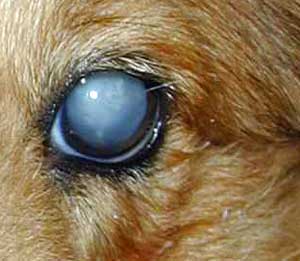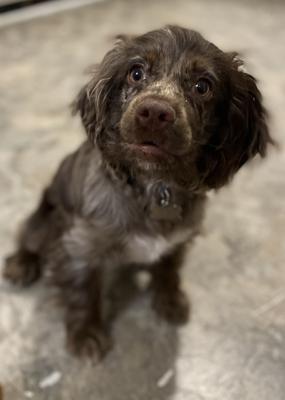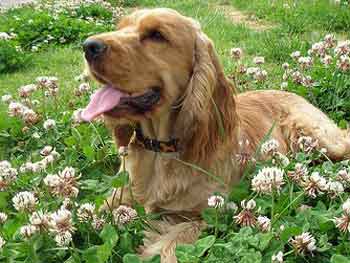- Home
- Cocker Spaniel eye problems
Cocker Spaniel Eye Problems: How To Keep Your Dog's Eyes Healthy!
Cocker Spaniel eye problems can make your dog's life a misery!
Understanding what conditions can affect your dog's eyes and treating them before they get out of hand will drastically reduce your pet's risk of problems with his peepers.
Learn how to spot the early signs of trouble, treat common dog eye problems and keep your precious little Cocker Spaniel's eyes sparkling and healthy!
Common Eye Problems in Dogs
Many conditions could affect your Cocker Spaniel's eyes during his lifetime.
Some are hereditary, like retinal dysplasia. Others are caused by viruses, bacteria, poor hygiene, or allergens such as dust or pollen.
Good breeders will screen their dogs for eye health before mating their Cockers to ensure the resulting puppies' eyes are healthy.
However, not all breeders are so responsible, and many don't test their dogs, which is why we see so many eye problems in Cocker Spaniels.
Below are several common eye conditions in dogs that may affect your Cocker Spaniel, with symptoms and a link to more detailed information on each particular issue.
Dog Eye Problems: Glaucoma In Dogs
Glaucoma is a condition that creates an abnormal increase in pressure inside your dog's eye, which, long-term, can result in irreversible blindness for your pet.
The inside of a normal, healthy eye produces a clear fluid called aqueous humour, which nourishes the eye.
A healthy eye will maintain a fluid and drainage balance, which helps keep the correct pressure inside the eyeball.
No problems with my eyes!
Glaucoma occurs when there's a problem with drainage, which increases pressure inside the eye, which causes the eyeball to bulge and can lead to eventual blindness.
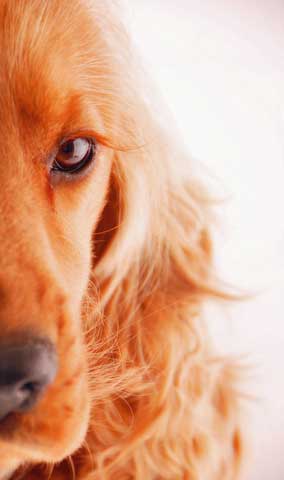 No problems with my eyes!
No problems with my eyes!Symptoms of Glaucoma include pain, red eyes, sensitivity to light, and protruding eyeballs.
Treatment can involve temporary medicines or surgery depending on the type of Glaucoma (primary or secondary). However, your dog may still eventually lose his eyesight despite treatment.
You can learn more about Glaucoma in dogs here.
Cocker Spaniel Eye Problems: Conjunctivitis
Canine conjunctivitis, or 'pink eye' as it's commonly known, is a rather nasty-looking Cocker Spaniel eye problem and often looks worse than it is.
It is an inflammation or infection of the conjunctiva, the membrane connecting the eyelid to the eyeball.
The conjunctiva can become irritated by an allergic reaction to pollen, grasses, or infections caused by bacteria, fungi, or viruses.
Apart from redness and swelling of the eyelid, symptoms include watery eyes or a yellowish-green discharge, squinting, and itching.
Your dog may paw at his eye or try to rub his face on carpets and furniture for relief.
Conjunctivitis in dogs caused by an allergy isn't contagious.
However, conjunctivitis caused by an infection may be contagious to other dogs, so it's essential to be strict about hygiene to avoid passing this on, especially if you have other pets.
Your vet may prescribe antibiotic eye drops or ointment depending on whether the problem results from an allergy or an infection.
The bacteria that cause conjunctivitis differ from those that affect humans, so dogs can't pass the condition on to humans.
You can learn more about canine conjunctivitis here.
Cocker Spaniel Eye Problems: Entropion
As far as canine eye problems go, this is one of the most painful.
Entropion is a condition where your dog's eyelid rolls inward, which causes the eyelashes and fur to rub against the dog's eyeball, leading to considerable irritation, pain and, long-term, quite a bit of damage to the cornea.
Entropion usually affects both eyes simultaneously and can be in the upper or lower lids; however, it's more common in the lower lids.
Where entropion is hereditary, puppies may be born with it or develop it within the first 12 months; however, you will find it more often in older Cocker Spaniels.
Symptoms include pain, watery eyes, blinking, swollen lids, and ulcers.
Treatment involves creams or drops for the eye to help with lubrication and ease pain, but it won't cure the problem.
A surgical procedure called blepharoplasty is the only effective treatment.
Learn more about entropion in dogs here.
Cocker Spaniel Eye Problems: Distichiasis
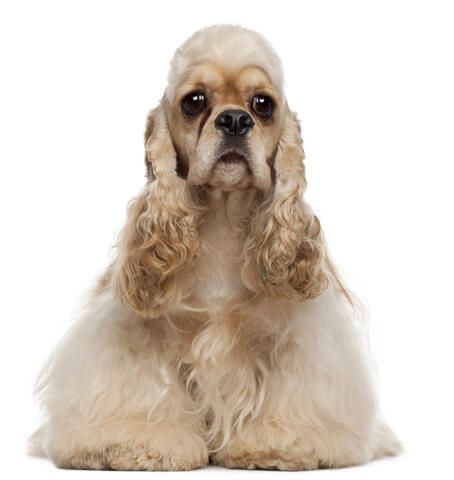 No Cocker Spaniel eye problems here, mine are shining!
No Cocker Spaniel eye problems here, mine are shining!Distichiasis is a condition where abnormal eyelashes (distichiae) grow from the oil glands in the dog's eyelid. These abnormal eyelashes can cause much irritation on the eyeball - ouch!
If the dog's hair is fine and soft, there may be no visible symptoms; however, with irritation, your dog's eyes may become red and/or inflamed. Your Cocker Spaniel may squint or try to rub his eyes with his paws to relieve the irritation.
Several treatments are available for Distichiasis, and your vet's choice will depend on the severity of the dog's eye problem.
The abnormal eyelashes may be removed manually, by surgery, or by using a form of electrolysis.
Surgery may be followed with antibiotics to prevent infection and help clear up any ulcers or conditions caused by the distichiasis.
Cocker Spaniel Eyes: Ectopic Cilia
Ectopic Cilia is similar to Distichiasis, but the hair grows from the inner surface of the eyelid.
It can cause squinting, tearing or discharge, ulceration, and cornea clouding. Your poor Cocker may paw at his eyes to try and relieve the irritation and/or pain; keep a watchful eye on your dog for these symptoms.
This condition can be excruciating for your dog and cause corneal ulcers.
Ectopic Cilia may be treated the same way as for Distichiasis, i.e. the lashes causing the problem are removed, followed by antibiotics to control infection.
Dog Eye Problems: Eyelid Tumours (Cancers)
You will usually find eyelid tumours in middle-aged to older dogs.
It is possible to treat tumours successfully with surgery; however, if the tumour is not removed while it's small, it can grow large and destroy the eyelid.
Conjunctivitis and discharge are common in dogs with growing eyelid tumours.
Cocker Spaniel Eye Problems: Cataracts
If your dog has cataracts, his eyes will appear cloudy, and his vision may be affected.
You may notice that he has trouble seeing things properly and may begin to walk into otherwise familiar objects.
If your dog's cataracts are left untreated, they will eventually lead to blindness. However, surgery can successfully remove them, especially if treated early.
A cataract in one eye only is likely to have resulted from physical trauma; however, where cataracts appear in both eyes, they are probably hereditary.
As cataracts can be hereditary, when buying a Cocker Spaniel puppy, it's advisable to check that there's no history of cataracts in either parents or grandparents.
Learn more about dog cataracts.
Prolapsed Third Eyelid Gland: PTEG
PTEG is also often referred to as 'Cherry Eye'.
Your Cocker Spaniel has a third eyelid that protects his eyeball.
This third eyelid also contains a tear gland, and Cherry Eye is where the tear gland bursts out of its normal position and appears in the inside corner of the eye as a red swelling.
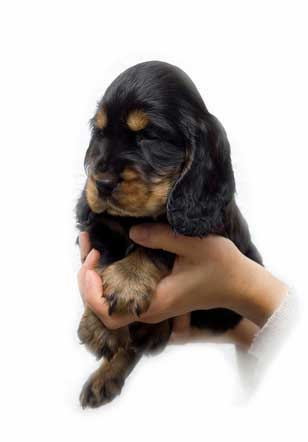 Cocker Spaniel eye problems can be avoided
Cocker Spaniel eye problems can be avoidedIf your dog is unlucky enough to develop PTEG, your vet will probably recommend surgery to suture the gland back in place.
After the surgery, however, your Cocker may be at risk of developing dry eyes.
Dry Eye (Keratoconjunctivitis Sicca)
Dry eye is also known as KCS, Keratoconjunctivitis Sicca.
It's a condition where your pet's eyes don't produce enough tears to lubricate the eyeball, which results in the eyes becoming dry and irritated.
Dry eyes can lead to infections, injured corneas and, in severe cases, blindness.
Symptoms include redness and obvious irritation, squinting, lack-lustre eyes, dislike of light, and discharge.
Your vet will treat KCS with antibiotics and corticosteroids.
Lenticular or Nuclear Sclerosis
Lenticular or Nuclear Sclerosis is an age-related condition in your dog's eyes.
As Cocker Spaniels grow older, the lenses of their eyes can become hardened and turn a cloudy blue-grey which can look very similar to cataracts.
This condition requires no treatment and probably won't affect your pet's eyesight until the very late stages. However, your Cocker Spaniel's eyesight would have deteriorated to that point due to old age anyway.
Progressive Retinal Atrophy (PRA)
PRA is an inherited dog eye problem to which Cocker Spaniels may be prone, leading to eventual blindness.
Early symptoms include dilated pupils, night blindness and difficulty in low light.
Your dog may bump into things or hesitate to walk down steps or stairs, and his eyes may look as if they're glowing or shining.
Unfortunately, there is no treatment for progressive retinal atrophy; however, it may no longer be a hopeless disease, according to Animal Eye Care.
Cocker Spaniel Eye Problems: Summary
Your dog may suffer from canine eye problems at some point, although less if the puppy's parents' eyes were health tested.
Although you may be unable to prevent hereditary diseases, regular checks and weekly cleaning can help keep other eye conditions at bay.
 This gorgeous puppy has beautiful, healthy eyes!
This gorgeous puppy has beautiful, healthy eyes!If you are to spot the early signs of dog eye health problems before they can worsen, you must be vigilant. Check your Cocker Spaniel's eyes often, at least weekly.
I usually check Max's eyes when talking to or cuddling him, but they're thoroughly checked and cleaned when I groom him.
So many pet owners wait a few days (or more) to see if the symptoms clear. Or, they want to avoid bothering the vet with something that appears relatively minor.
Unfortunately, that's often a big mistake!
Your pet must see his vet when you notice your dog's eye problems; prompt diagnosis and treatment are vital for eye health care.
By being vigilant and catching problems early, before they escalate, you will minimize any discomfort for your pet, keeping damage to his eyes to an absolute minimum.
Meanwhile, we can do lots to keep our pet's eyes healthy and help avoid those nasty eye problems in the first place!
Important Note: Any checks we do at home should never replace those your vet will carry out on a routine visit. Your vet can pick up on your dog's health problems long before you do.
Photo Credits for Cocker Spaniel Eye Problems:
1. Alexsandar Radovanovic at http://www.dreamstime.com/royalty-free-stock-images-cocker-spaniel-image23421259
2. Isselee at https://www.dreamstime.com/royalty-free-stock-photography-american-cocker-spaniel-1-year-old-sitting-image21061747
3. Uciekinier at https://www.dreamstime.com/stock-image-cocker-spaniel-puppy-image5257081
4. Olga Chernetskaya at
http://www.dreamstime.com/puppy-cocker-spaniel-image18581224

